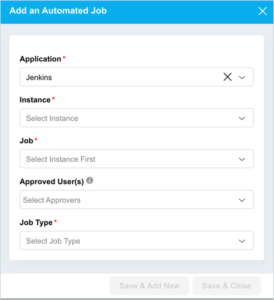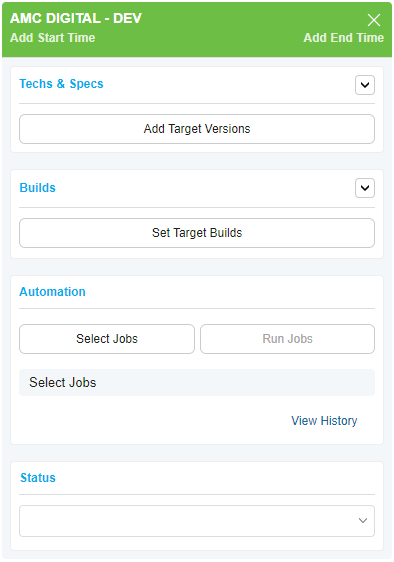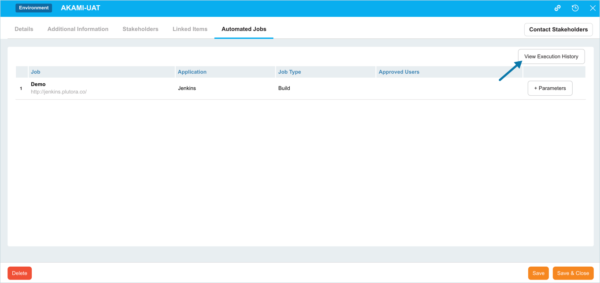Plutora’s Integration Hub allows automated jobs and orchestrated events from any application that supports APIs. Jenkins Integration allows automated jobs from Jenkins.
1. Enable and Configure Automated Jobs
Enable and configure automated jobs in Integration Hub and Jenkins Integration.
2. Add Automated Jobs to Systems
Automated jobs that have been enabled and created in Integration Hub and Jenkins Integration can then be added to Systems, where they flow down to the System’s Environments, and from there to TECRs and Deployment Plan Activities.
To add and sort the run order of automated jobs in a System:
- Go to Environment > Systems.
- Click to open a System.
- Under the Automated Jobs panel:

- View a list of the automated jobs associated with the System:
- The jobs cascade down to the System’s Environments and those Environments’ TECRs.
- If multiple jobs are selected, they will be run from the top of the list to the bottom. Reorder jobs by dragging and dropping.
- View a list of the automated jobs associated with the System:
- Add or edit automated jobs from Jenkins or Integration Hub:
- Click New Job.

- Select Jenkins or IntegrationHub from the Application drop-down menu.
- Select a Jenkins Instance.
- Select a Job:
- Jenkins jobs: Select a Job.
- Integration Hub jobs: Type the Job name.For Integration Hub the value entered into the job field here will be passed through as a parameter to the script. The script should be able to run multiple jobs, based on this parameterized input.
- Select Approved Users.If selected, only these users or User Groups can run the job.
- Select Job Type.
- Click Save & Close.
- Click New Job.
3a. Run Automated Jobs from a TECR
Use automated jobs to execute a TECR:
- Go to Environments > Requests.
- Click the TECR tab.
- Click to open a TECR.Users must have the Update TECR user permission.
- Scroll down to the Environments.

- Click Select Jobs to select the automated jobs to run. These are inherited from the TECR’s Environment’s System:

- Click to select the checkboxes of the automated jobs you would like to run for this TECR:
- Jobs are run in order of the list.
- Sort the list order in the System.
- If a job has an Approved User, only that user can run the job or change the parameters.
- Select Parameters:
- Click + Parameters and select or type the parameters for this TECR:
- If default parameters have been defined in either Jenkins or Integration Hub job, their values can be edited at this point but new parameters cannot be added.
- Click Save & Close.
- Click + Parameters and select or type the parameters for this TECR:
- Once jobs are selected, the Environment’s status bar will say Ready to Build.
- Click Save & Close.
- Click to select the checkboxes of the automated jobs you would like to run for this TECR:
- Click Run Automated Jobs:
- Running is only possible once one or more Automated Jobs have been selected.
- If approved users have been set for the job in the System, only those users can run it.
- The last build status will change from Requesting to Running and show the success or failure of the build upon completion. The loading gif will run until the build is complete.
- If more than one job is run at once the last job status will be shown on the TECR.
- Any Layers To Be Changed will be applied to the Environment upon successful completion.
- If Builds are enabled they will be applied to the Environment upon successful completion.
- Click Save.
3b. Run Automated Jobs from a Deployment Plan Activity
Use automated jobs to execute a Deployment Plan Activity:
To run automated jobs from a Deployment Plan Activity:
- Go to Deployment > Manager.
- Click to open a Deployment Plan in Draft mode.
- Click the Activities tab
 (on the left).
(on the left). - Click to select an Activity.The Deployment Plan Activity must have a System selected that has automated jobs, plus one of the System’s Environments.
- Click Select Jobs to select the automated jobs to run. These are inherited from the Deployment Plan Activity’s Environment’s System
Click to select the checkboxes of the automated jobs you would like to run for this TECR:- Jobs are run in order of the list.
- Sort the list order in the System.
- If a job has an Approved User, only that user can run that job or change the parameters.
- Set Parameters:
- Click + Parameters and select the parameters of each of the jobs you have selected:
- If default parameters have been defined in either Jenkins or Integration Hub job, their values can be edited at this point but new parameters cannot be added.
- Click Save & Close.
- Click + Parameters and select the parameters of each of the jobs you have selected:
- Click Save & Close.
- Once the Deployment Plan is in Execution mode, the automated jobs can be run by clicking Run Automated Jobs:
- Running is only possible once one or more Automated Jobs have been selected.
- If approved users have been set for the job in the System, only those users can run it.
- The last build status will change from Requesting to Running and show the success or failure of the build upon completion. The loading gif will run until the build is complete.
- If more than one job is run at once the last job status will be shown on the Deployment Plan Activity.
- The Activity Status will be updated based on the outcome of the jobs.
- If Builds are enabled they will be applied to the Environment upon successful completion.
4. View the Job Execution History
There are multiple places users can see the automated job run history.
TECRs
- Go to Environments > Requests.
- Click the TECR tab.
- Click to open a TECR.
- Click View History in an Environment for the job execution history of that TECR only, including the name of the job, execution date and time, the parameters used for the execution, and the application used.

Deployment Plan Activities
To view the execution history in a Deployment Plan Activity:
- Go to Deployment > Manager.
- Click to open a Deployment Plan in Draft mode.
- Click the Activities tab
 (on the left).
(on the left). - Click to select an Activity.
- Click View History.
Environment Manager
- Go to Environment > Manager.
- Click to open an Environment.
- Click the Automated Jobs tab.
- Click View Execution History to see all the automated job execution logs for that Environment, including every associated TECR and Deployment Activity job.

Integration Hub
See API – Integration Hub for viewing the execution history and also for stopping Integration Hub jobs.
